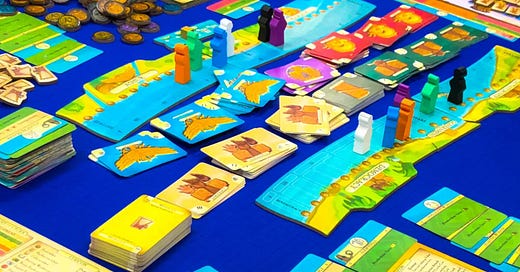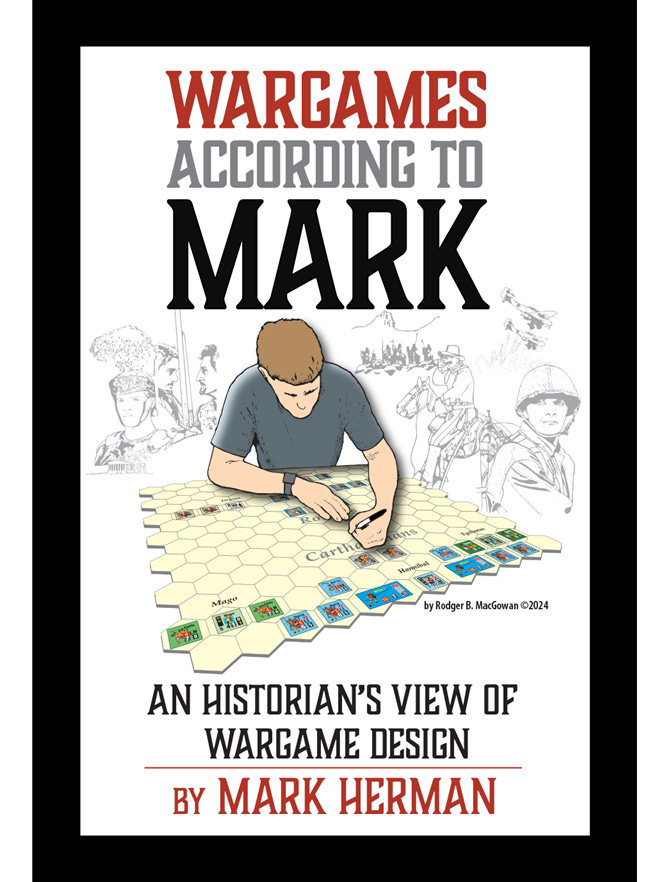In most games, doing more of something is better. Getting all the territories, harvesting all the resources, or catching all the criminals is better than getting not as many territories, resources, or criminals. Same with avoiding bad things. If you can take zero damage, that’s better than taking two.
But there are some games that have a twist on this. Getting more of something is good, but only up to a point. Once you go above a certain value, it turns against you, and is bad. I call this a Sweet Spot Mechanism (although it didn’t make the book!). You want to keep something within a range, and not be too high or too low. I guess you could also call it a Goldilocks Mechanism, but I like the alliteration of Sweet Spot.
A great example of this is Josh Buergel’s The Fox in the Forest, which is a trick-taking game for two players. Interestingly, many games that feature this mechanism are trick taking games.
In The Fox in the Forest, there are 13 tricks, and each is won by one of the two players. You score points based on how many tricks you take. So the tricks could be split 7-6, 9-4, or 13-0. In general, getting more tricks is better, but only up to a point. In you get 7 tricks and your opponent 6, you would get 6 points and they would get 3. If you split 9-4, you still get 6 points, but your opponent only gets 1.
But if you get one more than 9-4 – if you get 10 tricks, you score 0 and your opponent scores 6. So 9-4 is the best split for you.
This mechanism adds a tremendous amount of texture to a hand. If it was simply that you scored the most points by taking the most tricks, the strategy would be straightforward – win as many as you can. But by making 9 tricks great and 10 tricks terrible, the players may switch from trying to win tricks to trying to lose tricks, and when you realize when to make that switch is critical to playing well.
The traditional card game Hearts is similar, if you consider the Shoot-the-Moon mechanic. Ending a hand with 25 points is terrible. But if you get the 26th point, you instead stick all the other players with 13.
In the Stefan Dorra trick taking game Die Sieben Siegel – now published as Sluff Off! – players take chips representing how many tricks they think they can take. If they take exactly that number – great. If not, either high or low, they lose points.
In Trade on the Tigris, designed by me and Ryan Sturm, players move on two tracks - government and religion.
As you move towards the ends of the tracks you get access to higher level technologies, and higher end-game VP. But each track ends in a pretty bad space. Here’s a close-up of the government track, on the Democracy end:
The key features are circled in red. If you go too far and end up with Bureaucracy you go down from Level III cards to Level I cards, and the VPs (in the coins) drops from 15 to 10.
You only reach the ends of these tracks towards the end of the game. So the last few trading rounds see players trying to make sure that the ideas they bring into their kingdom keep them in that best space. It makes for a tense and exciting finale (at least in this designer’s opinion).
And it also has a fun thematic element. Too much Democracy moves you into Bureaucracy, as you see above. The other end of the track is Dictatorship, which can give you access to fun aggressive technologies, but if you go too far you end up in Tyranny. And the ends of the Religion track are Zealotry and Idolatry.
In my game The Dragon & Flagon, players have a character in a tavern brawl. Each has a core set of actions that are shared by all characters, but there are five that are unique to each. In earlier iterations of the game, you took damage and could get knocked out of the game. To add some interest and texture, we had a mechanism where you started with none of your special character actions. As you took damage, you earned your special actions. So as you came closer to losing you got more powerful. Many players tried to get damaged early so they could get access to their cool cards. The danger, of course, was that if you went too far you could get knocked out. So you wanted to take damage, but not too much damage.
We ended up eliminating players getting knocked out, and that mechanism went with it. But it was really a fun feature when it was included.
So this Sweet Spot mechanism adds a lot of interest to games where it is included. And we see this all the time in science, product design, and engineering. As we are searching for exoplanets orbiting other stars, we are looking for ones that are not too close to the sun – where they will be scorching hot and have no liquid water – or too far away, where they will be frigid. We are most interested in planets that are in that in-between goldilocks zone.
In a similar vein, when creating a product, the designer needs to balance different features. If you’re designing a laptop you need to balance the size and power of the parts with the size of the case – too large and no one will have room for it on their desk, too small and you won’t be able to fit everything in, and it will get too hot.
Situations like this are way more interesting than strictly “more is better” and require expertise and finesse. I would love to see the sweet spot mechanism incorporated into even more games.
“Moderation in all things”.
Harley Quinnball
The next installment in the Super Skill Pinball series will be releasing at Gencon - Harley Quinnball!
It was my absolute pleasure to get to play in Harley’s world for a little while - and have an excuse to buy her comics!
Some of the fun features of the different tables:
Coney - This table is near and dear to my heart as my family heritage goes through Coney Island. Fun fact: My great-grandfather Samuel Engelstein started the Great Coney Island Fire of 1911. This table introduces the Wonder Wheel minigame, and the Parachute Jump. It also has special Leap abilities that Harley can earn.
Joker Tower - Honestly my favorite of the bunch, but just by a nose. You can see the images for this in the IGN article - it's the first table where the two boards are both in 'portrait', and there are four levels to climb. Each is its own mini table with special challenges, and has its own flippers. When you go up a level you can't go back down. Ultimately you are trying to defeat the Joker on the top level, which actually ends the game. Bonuses on different levels combo with each other, so you need to choose which you want to try to carry upwards. This is a one-ball machine - if you lose the ball you're done.
This table design was inspired by the very rare The Pinball Circus, which I got to play in Las Vegas. There's only two or three in existence. Pics here: https://www.ipdb.org/machine.cgi?id=4354
Suicide Squad - There are five Suicide Squad members you can recruit during the game. You start with one (at random), and can earn others through the AMANDA targets. Each member has a different special ability, but each time you use it there's an increasing chance that their heads explode. Big points are available if you can take down Starro, who dominates the center of the board. You need to hit all his tentacles before you can go for the eye and get the bonus.
Gotham Gems - If you like multiball (and who doesn't!), you'll love this table. It's very easy to get multiball in this one, and you can get it any number of times. Each time you get it your teammate is chosen by the final target you hit - either Poison Ivy, Catwoman, or Black Canary. Each teammate gives triple points for certain targets, so you need to decide between grabbing points when you can, or switching partners to really ramp it up.
Hope this gives you a little flavor, and you enjoy the game!
I will be at the Wizkids booth at Gencon Thursday afternoon from 2-4 giving demos, and signing. Please stop by and say hi!
Wargames According to Mark
Veteran war game designer, co-designer, and friend Mark Herman has written what is destined to be a vital reference for game designers - Wargames According to Mark. I was a test reader on the final version, so I feel very comfortable vouching for it.
The book is currently available for pre-order from GMT Games.








Cthulhu: Death May Die has an insanity track. When you advance on it, you unlock special abilities and get bonus dice. However, when you reach the end of the track, your character succumbs to the madness and is eliminated. It often creates very tense moments, you need the extra power to kill the elder one but if you push too soon you lose.
Angola, by the Ragnar brothers, has lots of clever mechanisms including one that is a form of sweet spot. I think it is thematically accurate too. If your faction starts losing then its allies (Cuba, South Africa or the US) will supply more sophisticated weapons. If you carry on losing, though, they will take them away and you are probably doomed.